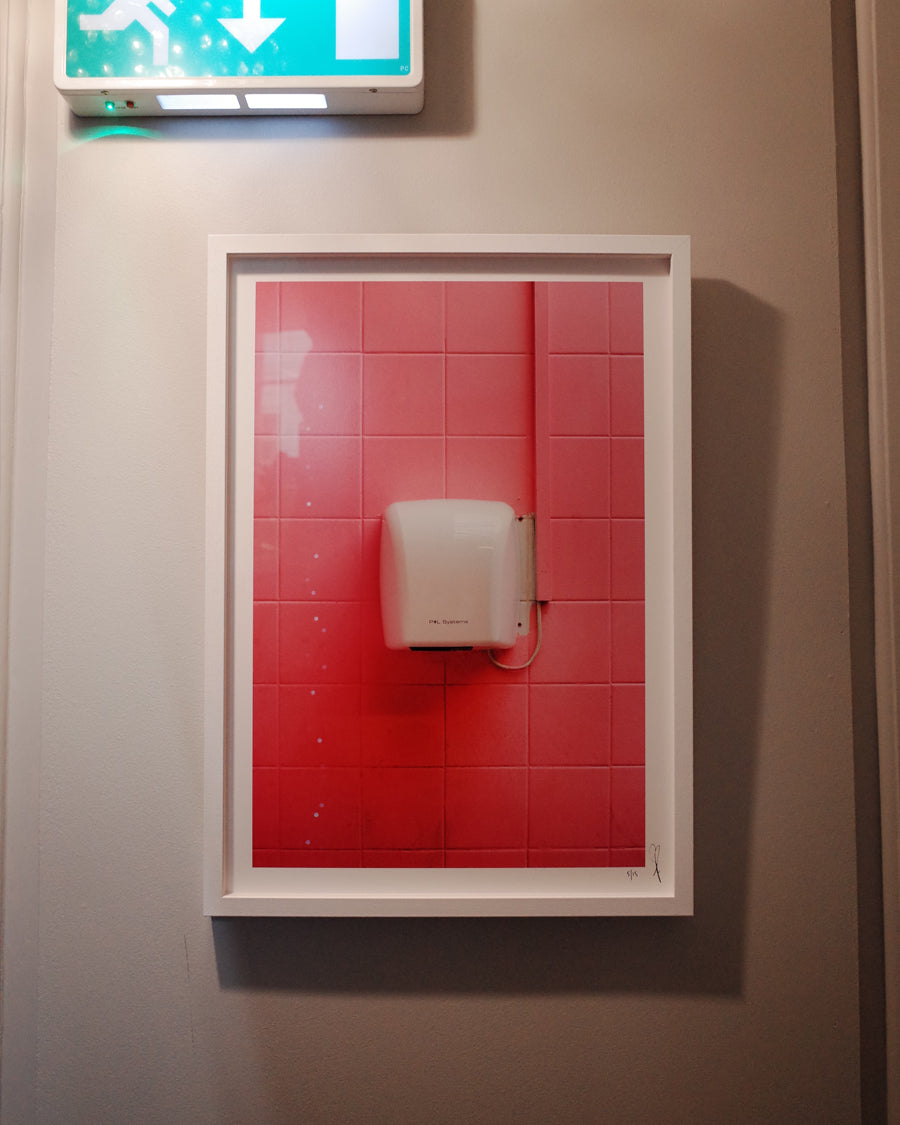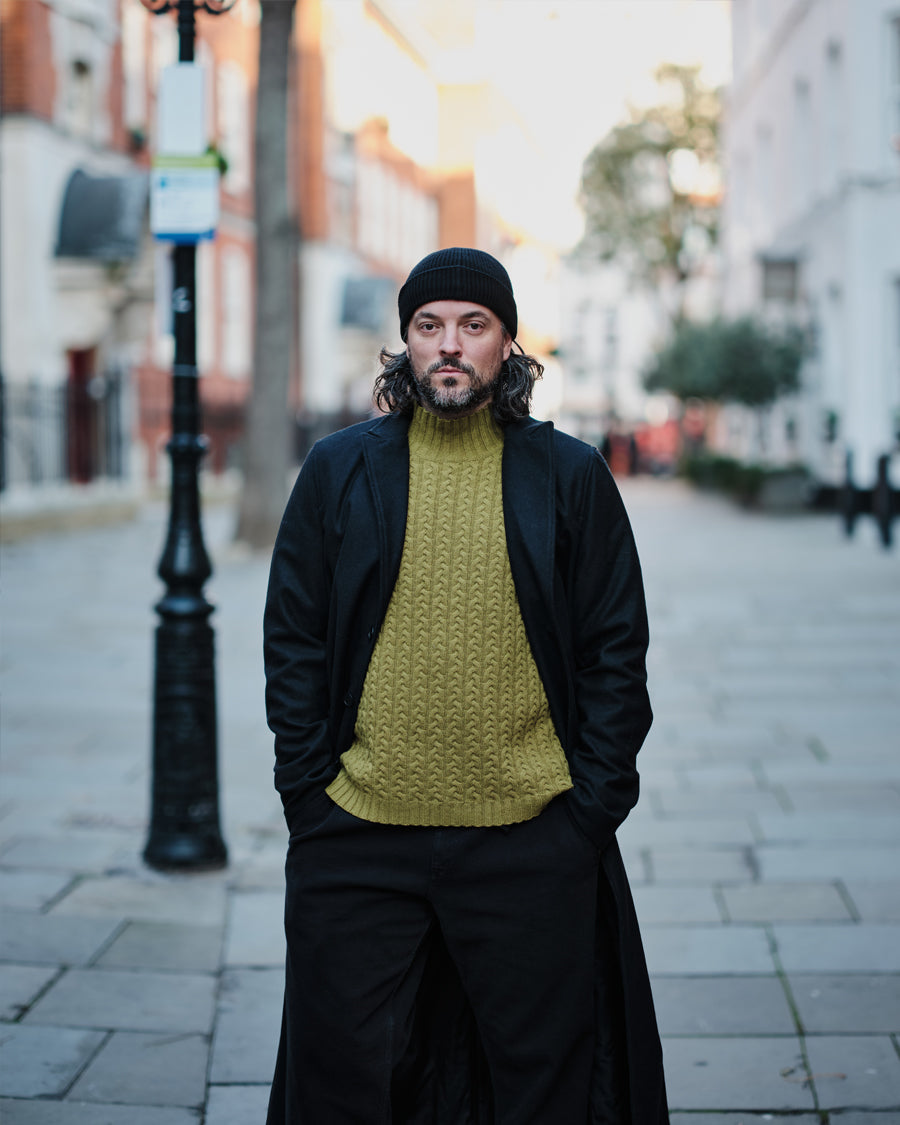
Harvey James | Wax Edit
Harvey James knows good clothing - it’s literally his job. As Associate Editor at SLMan, he spends his days hunting down the latest and greatest in...
Read moreWelcome to Wax:
Posted on: December 11, 2022 – Words by
This week we caught up with Sam Ryde, the creative and visual artist behind the Instagram pages handdryers and telephonebooths. We were lucky enough to visit Ena Salon where Sam works 5 days a week as a hairstylist, and even explore central London to see some of his favourite telephone boxes and hear the story behind them.
We discussed everything, from failing a photography A-Level, to finding the time to balance passion and profession, to what’s next for Sam in 2023 and lots in between. Read below to find out more, and the inspiration behind why Sam photographs hand dryers and telephone boxes specifically.
Sam wears Stoner Jumper Moss
How do you find time to balance both sides of the coin, your work as a hairstylist, and your creative work as a visual artist?
To be honest, the only way I can balance the two is if I sacrifice my personal time. I still work in the Salon full time, and then the creative stuff I squeeze in either between clients if I’ve got enough opportunity, or I have to take holiday if I’m doing a show, or after work, or my days off. So, basically I sacrifice my spare time to do both.
Have you always been into visual art and photography?
I did an A-Level in photography when I was 18 (and to be honest with you.. I actually failed it!), but I didn’t pursue any of my A-Levels. I went straight into work, as I thought University would be a waste of time for me, and I still think it would’ve been a waste of time for me. But Photography is something I’ve always done, and it was a hobby that organically grew into something else. And when I got the opportunity to scale it up, I just took it.
Your visual photography is amazing. It’s so aesthetically pleasing, and captures something so simple and turns it into art. What first inspired you to photograph hand dryers and telephone booths? Why hand dryers? Why telephone booths?
I’m a sucker for a series, I’m a strong believer that if you have a series of things they are stronger than the sum of their parts. But with the hand dryers, initially it was kind of a product design interest.. There are so many varieties and so many that are useless; they didn’t work, or whatever and I started to wonder who put them there, or who cared enough to point out they were broken but not enough to fix them. And then I thought there was something in it, so I put them on Instagram and everyone thought I was crazy. But slowly, surely, they found their narrative and I began to explore what bathrooms are and what they mean to humanity and the way we treat them. I think that bathrooms are unique, in that, when you’re in a bathroom and you lock it, you have an anonymity that you can’t have anywhere else. So what you choose to do, or how you choose to behave within that anonymity I think is a representation of the truest version of yourself.
With phone booths, I have always been interested in phone booths. When I was a kid, and we didn’t have mobile phones, you were chained to phone boxes but emotionally the importance is still there; they are still life saving. I think the phone boxes, like the bathrooms, represent our ability to forget the things that aren’t important and as soon as this happens, we ignore them, we mistreat them, they become invisible. But yet there is still this lifetime of servitude, waiting to be used, and in the meantime they are just beaten up and written on. They are kind of sad and strong at the same time, a poetic symbol of the resilience of humans.
Sam wears Condo Coat Black Melton Wool & Fisherman Beanie Black
How do you capture the images, do you go on special trips to see and find hand dryers worth photographing, or do you just snap the ones you see in everyday life?
Yes! I just did one last week. I went to New York for three days to get some new content for an exhibition I’ve got in January. The only problem is there’s a lot of walking and there’s a lot of bars, and if you are lucky enough to find one online, the chance of it being the same by the time you get there is so slim. So the mile per success rate is quite high. I do worry that I’m going to run out, so I need to explore some new cities soon!
How do you decide what is worth photographing and posting? Do you have aesthetic requirements?
Not really. I think you can post anything on Instagram. On stories you can certainly post anything and I’m a bit more thoughtful at what goes on my permanent feed. For an exhibition, they have to be exceptional or have an amazing reaction and it takes a lot of hunting to get things that really stand out, that I feel comfortable exhibiting. Especially, when you’ve got a subject matter which is.. Niche, to put it mildly.
Where do you get your works printed for exhibitions?
It’s a mixture. There’s a place called Metro in Clerkenwell, they are fantastic. They print for the photographer’s gallery and Natural History Museum. The Acrylic ones are printed at Print Foundry who also print for Natural History Museum as well actually. They’re both really good. The best thing about Print Foundry is they come ready to hang.
What have been your favourite moments on your photography journey so far?
Getting a book deal was pretty special, the day it was in New York Times was pretty special, first exhibition was pretty special, seeing it in a shop for the first time was pretty special. I really wanted my book to be in Art & Books, so I went in with my chest puffed and the lady was on the phone so I was looking around the shop and then I saw it there on the shelves! That was really pretty special. It’s been an amazing journey, I didn’t think that was going to happen.
You’ve brought out a book, congrats! How was the experience of creating that?
When I made the book, there were 3000 images and we had to figure out how to present them. There was minimal, white minimal, colourful and miscellaneous. Initially we stuck them all in, but it was a bit too much. So we stripped them back, turned them into grids, the really special ones got their own page and broke up the journey to make it more interesting. I think 2000 hand dryers in the book would kill you, but we got it down to 360, so we just had to be ruthless while keeping one eye on aesthetic, one on making sure we had lots from America included.
How did you get James Dyson to write the foreword for your book?
Sir James Dyson wrote the foreword because the publisher had previously published a book about his school art teacher. This man was the one who recommended that Dyson be a product designer, so he wrote the foreword for his book too. And with the subject matter being handdryers it felt quite fitting!


Do you sell your art as NFTs?
Yes, I’ve just started. I actually just got back from Miami where I did an NFT exhibition which was amazing. Some of the guys in there had never exhibited before, so it’s like there are two different art industries; physical and nfts. The NFT stuff is a different world, most of those I’ve met don’t exhibit physically, they only exhibit digitally and some of them are making hundreds of thousands a week! But, it’s another job… and I’ve already got two jobs. So I just don’t have enough time, but I’d like to. Then it could pay for me to tour around the world and take photos of hand dryers which is all I want to do and I don’t think that’s too much to ask.
Lastly, what’s next for your visual art and for you, in 2023?
I’ve got my first solo exhibition at Reem in Soho. And then affordable art fairs across europe and LA and a 6 week residency in the Bankside hotel and then the art fair in Dallas. I just want to push as much as possible, until I run out of push really…
Harvey James knows good clothing - it’s literally his job. As Associate Editor at SLMan, he spends his days hunting down the latest and greatest in...
Read moreTrees are shimmering in the windows of homes, children are darting about with joy on their faces, and you’ve once again saved your gift shopping fo...
Read more